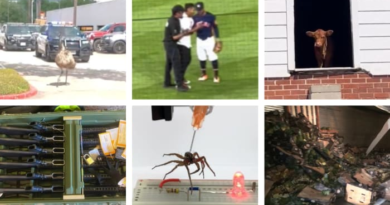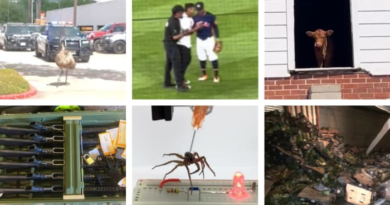Dogs can ‘see’ with their noses, study suggests – NBC News
Profile
Sections
tv
Featured
More From NBC
Follow NBC News
Dogs are renowned for their ability to identify and track objects by scent. Now it’s been revealed they enhance this talent with special brain structures that link it to how they see.
A study published this month in the Journal of Neuroscience revealed that vision and the sense of smell are connected in the brains of dogs, something not yet found in any other species.
“The most interesting thing about this research are the connections from the nose up to the occipital lobe, which houses the visual cortex,” said veterinary neurologist Philippa Johnson, an associate professor at Cornell University’s College of Veterinary Medicine and senior author of the study.
She and her colleagues studied MRI scans of the brains of 23 dogs that showed neurological connections between the olfactory bulb, where smells are recognized, and their occipital lobe, where vision is processed.
Humans, who rely mainly on vision, have no such connections in their brains, although it’s possible there’s something similar in other animals that depend heavily on scent, Johnson said.
The discovery suggests smell and vision in dogs are integrated in some way, although it’s not known how dogs experience the two senses functioning together.
“Scent contributes to the visual cortex in dogs, but a dog’s experience is hard for us to know,” Johnson said. “But I think they can use scent to work out where things are.”
She explained that when humans walk into a room, they primarily use their sense of vision to establish who is there or how furniture is positioned. But dogs seem to integrate scent into their interpretation of their environment and how they are orientated in it, she said.
That’s borne out by the behavior of dogs that have lost their vision but don’t seem greatly affected by the fact that they have gone blind.
“One of the ophthalmologists at the hospital here said he regularly has owners that bring their dogs in, and when he tests their eyesight, they are completely blind — but the owners literally won’t believe him,” she said. “The blind dogs act completely normally. They can play fetch. They can orientate around their environment, and they don’t bump into things.”
Johnson and her colleagues are planning more studies to examine the brains of other animals, such as cats and horses, that depend heavily on smell.
”A horse’s head is predominantly a nasal organ, but they use scent in a different way to dogs, because they are prey animals and they use it for alerting themselves,” she said. “So it will be interesting to see how their nasal systems integrate into their brain.”
The sense of smell in dogs is known to be much more sensitive than in humans: the olfactory bulb in a dog’s brain is about 30 times larger than in a human brain. Dogs have up to a billion smell receptors in their noses, compared to just 5 million smell receptors in people, Johnson said.
But the discovery suggests the sense of smell is much more vital to dogs than previously thought.
“We already have an indication that their vision isn’t acute and as complex as human vision. However, we now know that scent is part of their visual processing, so dogs might have a completely different experience of the world compared to us,” she said.
James Serpell, an emeritus professor of ethics and animal welfare at the University of Pennsylvania School of Veterinary Medicine, who wasn’t involved in the study, said the finding suggests dogs somehow combine elements of smell and sight into their perception of the world around them.
“This would certainly help to explain why dogs that go blind seem to function so well, at least when they’re in a familiar environment where their olfactory sense can map onto their visual memories of spatial relationships,” he said in an email.
Palaeoanthropologist Pat Shipman, the author of “Our Oldest Companions: The Story of the First Dogs,” suspects the superior ability of dogs to detect and analyze scents was one of the reasons for their domestication from wolves up to 40,000 years ago — along with their abilities to see in the dark, to run much faster than humans and to hunt cooperatively.
“The whole advantage of domesticating another predator has to have been that the human gets something out of it that they didn’t have otherwise,” she said.
Such advantages seem to have made dogs especially useful to early humans who relied on hunting for much of their food.
“It’s been shown in several different ethnographic studies in several parts of the world that hunters who take a dog with them do better than hunters without a dog,” Shipman said. “Even allowing for the fact that the dog is going to eat some of the meat — because it’s got to get something out of this, too — you end up with greater yields.”
Their heightened sense of smell and other advantages may also have made dogs useful for protecting captured prey from other predators, such as wild wolves, she said.
“The easiest way to get food is to take it off somebody else who’s gone through all the effort of catching it,” she said. “But if you are there with your dogs — or your wolf-dogs, or whatever you want to call them — then they are going to pick up on another animal in the area much sooner.”
Tom Metcalfe writes about science and space for NBC News.
© 2022 NBC UNIVERSAL




